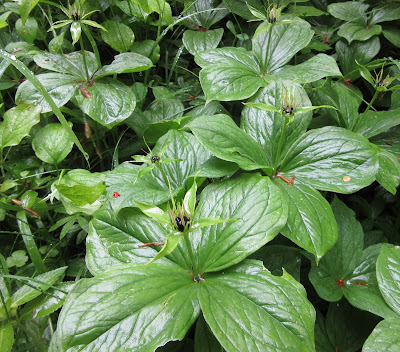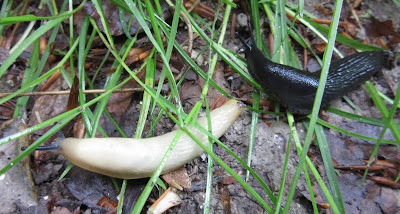I've never been to Warburg Nature Reserve before, so was really looking forward to a guided orchid walk today. The weather was a bit damp and dreary, but the 8 species of orchids, plus a couple of additional unusual plants that we saw, more than made up for that.
Warburg is a large BBOWT reserve, tucked away in the Chilterns, with a range of habitats from chalk grassland to deep woodland. These different habitats allow a great variety of orchids and other wildflowers to thrive.
Firstly, we found Lesser and Greater Butterfly Orchids growing next to each other, which was great to be able to compare the two. They are both elegant orchids with white flowers with a narrow lip and long, thin spur. Of the two, the Lesser Butterfly Orchid is the least common and is listed as vulnerable.
 |
| Greater Butterfly Orchids |
 |
| Greater Butterfly Orchid |
 |
| Lesser Butterfly Orchid |
To tell them apart, you have to look at the pollinia, which are widely spaced in the Greater and closely spaced and parallel in the Lesser.
 |
| Greater Butterfly Orchid |
 |
| Lesser Butterfly Orchid |
While we were looking at the Butterfly Orchids, we also saw some tiny Fly Orchids in amongst the grass. They are so small and delicate that you could very easily miss them.
 |
| Fly Orchid |
 |
| Fly Orchid |
We also found some Fly Orchids when we were in the woods later, but they were much taller plants than those out in the open.
 |
Fly Orchid - much taller stems when
they're in the shady woods |
In the deep shade of the Beech woods we found the strangest of the orchids we saw all day, the Bird's Nest Orchid. It's a honey brown flower that looks more like a dead stem than a flowering orchid. It has no chlorophyll so doesn't need to photosynthesise. Instead it's sustained by a fungus, which in turn forms a relationship with the nearby Beech trees. These unusual orchids are listed as near-threatened.
 |
| Bird's Nest Orchid |
We saw several patches of White Helleborines, both in the deep shade and in slightly more open locations. The flowers rarely open fully, which is why my Mum called them Lemon Pip Orchids when she was a girl.
 |
| White Heleborine |
Then we moved onto the open chalk grassland, where we found a few Early Purple Orchids that were well past their best and had almost gone over. There was lots of Twayblade in flower and the first Common Spotted Orchids were just starting to bloom.
 |
| Common Spotted Orchid just starting to flower |
 |
| Twayblade |
There were plenty of other treasures on the reserve, including a couple of quite unusual wildflowers. We found a few patches of Herb Paris, with it's very distinctive four leaves and tall star shaped flowers.
We took a detour off the main path and climbed up a slope covered in Dog's Mercury to find a fenced off area full of wild Solomon's Seal. I've only ever seen it growing in gardens before.
To top it all off we even found a summer fungus called Persistent Waxcap.
I think we would have struggled to find more than a couple of the great things we saw today if we were there on our own, so having a guide to show us where they're all hiding was great. It was a brilliant way to spend a rainy morning!



























































